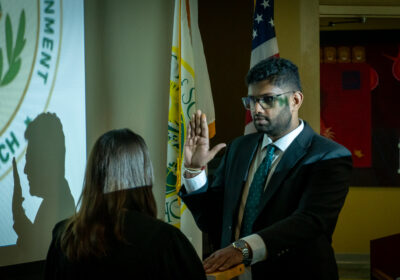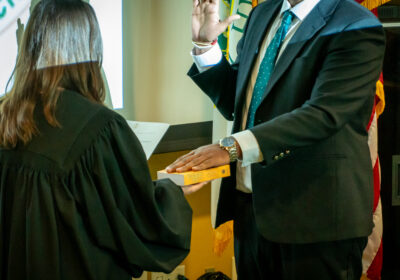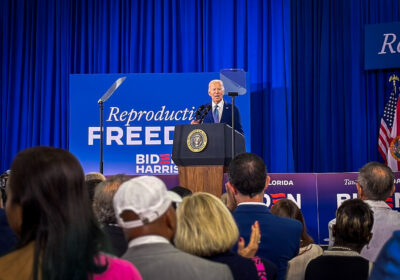A student’s guide to the 2016 candidates: Bernie Sanders

Bernie Sanders announced his participation in the 2016 presidential race on May 26. SPECIAL TO THE ORACLE
Self-described “democratic-socialist” Bernie Sanders has laced up his Velcro sneakers to take part in the 2016 presidential race in May, and the word that has recently dogged many politicians — “socialist” — doesn’t seem to have hindered him so far.
The junior senator from Vermont announced his candidacy for president May 26, and what many perceived as a fringe candidacy in the beginning has developed into a legitimate bid for the Oval Office. As a result, candidates and news networks alike have been forced to take him seriously.
According to Real Clear Politics, Sanders and his closest rival, former Secretary of State Hillary Clinton, have recently been fighting for the highest ratings in New Hampshire. Their numbers have hovered within 8 points of one another’s for months. The former mayor of Burlington narrowly trails 38.7-27 in Iowa and has work to do nationally with the polls putting him behind Clinton by around 20 points.
Last week’s democratic debate finally pitted the two rivals against each other, along with former Maryland Gov. Martin O’Malley, former Virginia Sen. Jim Webb, and former Rhode Island Gov. Lincoln Chafee.
In a key moment of the night, Sanders defended Clinton over her e-mail scandal, for which she will testify in front of Congress on Thursday.
“The American people are sick and tired of hearing about your damn emails,” the senator said to a grateful-looking Clinton, who shook his hand amid thunderous applause. The moment gave Sanders a huge boost on social media, with Facebook and Twitter reporting that he was the most discussed candidate on their websites.
One issue that has made Sanders hugely popular among millennials is college tuition reform. According to The Hill, 59 percent of college students polled chose Sanders as a favorite over Clinton, who got almost the same percentage of votes (18) as Vice President Joe Biden, which many have pointed out is particularly curious because Biden has not announced any intention to run.
Sanders’ platform on tuition reform holds that college tuition should be free. In order to do that, he has proposed a “Robin Hood Tax on Wall Street,” which would impose a fee on speculation of 0.5 percent. Additionally, he has suggested college Work Study reform that will provide more colleges with more money to sponsor Work Study positions for eligible students.
During the debate, Sanders made a point of emphasizing this need for tuition reform. Later, the Sanders campaign reported it had received an unprecedented $1.3 million in donations four hours after the debate concluded.
According to The New York Times, Sanders has raised $26.2 million, which exceeds all Republican candidates and puts him within $3.7 million of Clinton’s fundraising total, though he trails many candidates whose campaigns are funded by a super PAC in total funds.
The chief pillar of Sanders’ candidacy is tackling the issue of income inequality — something he said he believes is “the great moral issue of our time.”
On his campaign website, Sanders claimed “There is something profoundly wrong when the top one-tenth of one percent owns almost as much wealth as the bottom 90 percent.”
Additionally, the University of Chicago graduate has shown unwavering support for civil rights since the 1960s. In an interview with the Burlington Free Press, Sanders said it was unacceptable “that you had large numbers of African-Americans who couldn’t vote, who couldn’t eat in a restaurant, whose kids were going to segregated schools, (and) who couldn’t get hotel accommodations living in segregated housing.”
For these and other reasons, he became a protest organizer for the Congress of Racial Equality and participated in the March on Washington in 1963 — the same march that birthed Martin Luther King’s “I Have a Dream” speech.
His unwavering support extends to gay rights, as well. In an open letter published in 1972, Sanders called for an abolishment to all laws “dealing with abortion, drugs, and sexual behavior (adultery, homosexuality, etc.).”
As an elected official, Sanders voted against the Defense of Marriage Act of 1996, which stipulated marriage for federal purposes would be the union of one man to one woman and allowed states to refuse to recognize same-sex marriages granted under the laws of other states.
When the Supreme Court took up the issue in Obergefell v. Hodges in April 2015, Sanders again reiterated his support through his website, stating “It’s time for the Supreme Court to catch up to the American people and legalize gay marriage.”
His populist opinions appear to have resonated very well among potential voters, evidenced by the fact that attendance at the senator’s rallies are the envy of the 2016 race. A routine stop in Denver, Colorado drew an estimated 5,000 supporters, and a crowd of over 11,000 supporters attended a rally in Arizona — a state that hasn’t voted for a Democratic candidate in almost 20 years.
In addition, Sanders brought in 27,000 at a speaking engagement in Los Angeles hosted by female comedian Sarah Silverman and filled the Moda Center in Portland, Oregon to capacity.
“I’ve run outside of the two-party system, defeating Democrats and Republicans, taking on big-money candidates,” Sanders said in an interview with The Associated Press, “and I think the message that has resonated in Vermont is a message that can resonate all over this country.
“People should not underestimate me.”






